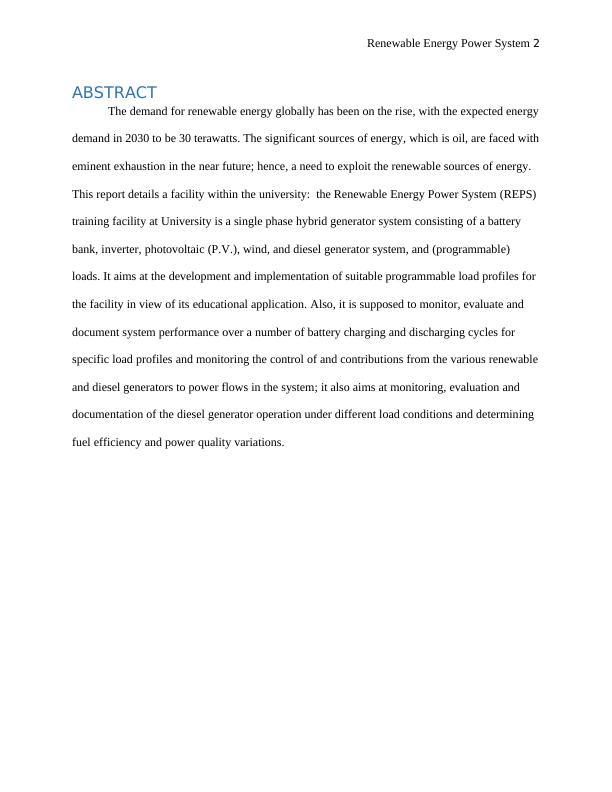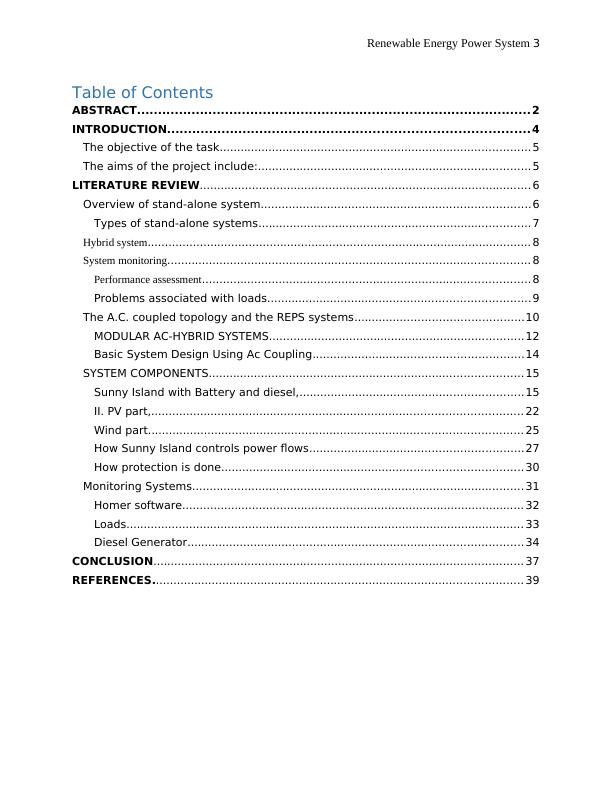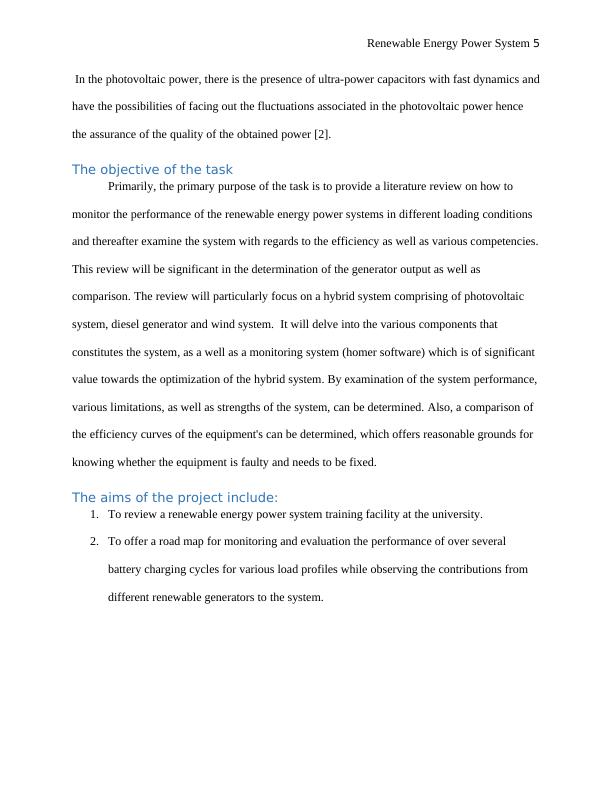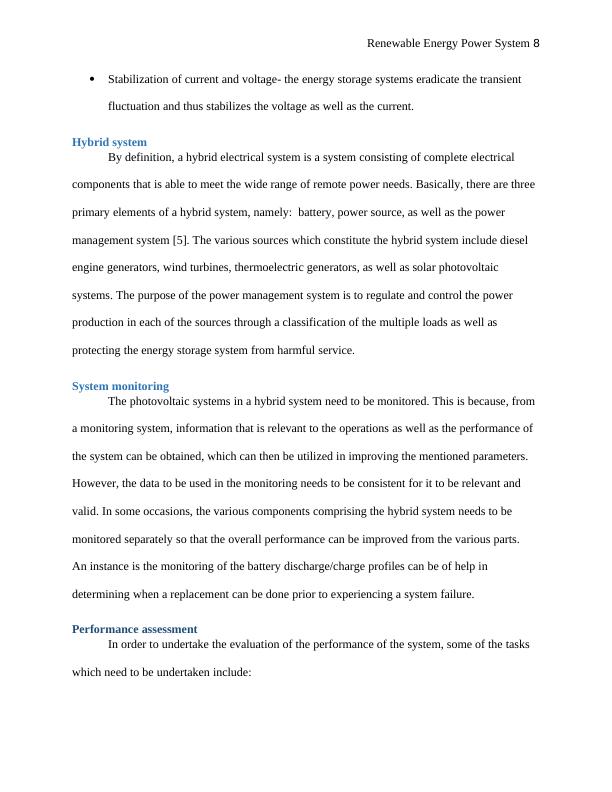Renewable Energy Power System Training Facility
Develop and implement load profiles, monitor system performance, evaluate diesel generator operation, simulate system using HOMER software.
45 Pages9726 Words402 Views
Added on 2022-12-15
About This Document
This report details a facility within the university: the Renewable Energy Power System (REPS) training facility at University is a single phase hybrid generator system consisting of a battery bank, inverter, photovoltaic (P.V.), wind, and diesel generator system, and (programmable) loads. It aims at the development and implementation of suitable programmable load profiles for the facility in view of its educational application.
Renewable Energy Power System Training Facility
Develop and implement load profiles, monitor system performance, evaluate diesel generator operation, simulate system using HOMER software.
Added on 2022-12-15
ShareRelated Documents
Renewable Energy Power System 1
RENEWABLE ENERGY POWER SYSTEM TRAINING FACILITY
By Name
Course
Instructor
Institution
Location
Date
RENEWABLE ENERGY POWER SYSTEM TRAINING FACILITY
By Name
Course
Instructor
Institution
Location
Date

Renewable Energy Power System 2
ABSTRACT
The demand for renewable energy globally has been on the rise, with the expected energy
demand in 2030 to be 30 terawatts. The significant sources of energy, which is oil, are faced with
eminent exhaustion in the near future; hence, a need to exploit the renewable sources of energy.
This report details a facility within the university: the Renewable Energy Power System (REPS)
training facility at University is a single phase hybrid generator system consisting of a battery
bank, inverter, photovoltaic (P.V.), wind, and diesel generator system, and (programmable)
loads. It aims at the development and implementation of suitable programmable load profiles for
the facility in view of its educational application. Also, it is supposed to monitor, evaluate and
document system performance over a number of battery charging and discharging cycles for
specific load profiles and monitoring the control of and contributions from the various renewable
and diesel generators to power flows in the system; it also aims at monitoring, evaluation and
documentation of the diesel generator operation under different load conditions and determining
fuel efficiency and power quality variations.
ABSTRACT
The demand for renewable energy globally has been on the rise, with the expected energy
demand in 2030 to be 30 terawatts. The significant sources of energy, which is oil, are faced with
eminent exhaustion in the near future; hence, a need to exploit the renewable sources of energy.
This report details a facility within the university: the Renewable Energy Power System (REPS)
training facility at University is a single phase hybrid generator system consisting of a battery
bank, inverter, photovoltaic (P.V.), wind, and diesel generator system, and (programmable)
loads. It aims at the development and implementation of suitable programmable load profiles for
the facility in view of its educational application. Also, it is supposed to monitor, evaluate and
document system performance over a number of battery charging and discharging cycles for
specific load profiles and monitoring the control of and contributions from the various renewable
and diesel generators to power flows in the system; it also aims at monitoring, evaluation and
documentation of the diesel generator operation under different load conditions and determining
fuel efficiency and power quality variations.

Renewable Energy Power System 3
Table of Contents
ABSTRACT..............................................................................................2
INTRODUCTION......................................................................................4
The objective of the task......................................................................................... 5
The aims of the project include:.............................................................................. 5
LITERATURE REVIEW............................................................................................... 6
Overview of stand-alone system.............................................................................6
Types of stand-alone systems.............................................................................. 7
Hybrid system.............................................................................................................. 8
System monitoring........................................................................................................ 8
Performance assessment.............................................................................................. 8
Problems associated with loads........................................................................... 9
The A.C. coupled topology and the REPS systems................................................10
MODULAR AC-HYBRID SYSTEMS.........................................................................12
Basic System Design Using Ac Coupling............................................................14
SYSTEM COMPONENTS.......................................................................................... 15
Sunny Island with Battery and diesel,................................................................15
II. PV part,.......................................................................................................... 22
Wind part........................................................................................................... 25
How Sunny Island controls power flows.............................................................27
How protection is done...................................................................................... 30
Monitoring Systems............................................................................................... 31
Homer software.................................................................................................. 32
Loads.................................................................................................................. 33
Diesel Generator................................................................................................ 34
CONCLUSION.......................................................................................................... 37
REFERENCES.......................................................................................................... 39
Table of Contents
ABSTRACT..............................................................................................2
INTRODUCTION......................................................................................4
The objective of the task......................................................................................... 5
The aims of the project include:.............................................................................. 5
LITERATURE REVIEW............................................................................................... 6
Overview of stand-alone system.............................................................................6
Types of stand-alone systems.............................................................................. 7
Hybrid system.............................................................................................................. 8
System monitoring........................................................................................................ 8
Performance assessment.............................................................................................. 8
Problems associated with loads........................................................................... 9
The A.C. coupled topology and the REPS systems................................................10
MODULAR AC-HYBRID SYSTEMS.........................................................................12
Basic System Design Using Ac Coupling............................................................14
SYSTEM COMPONENTS.......................................................................................... 15
Sunny Island with Battery and diesel,................................................................15
II. PV part,.......................................................................................................... 22
Wind part........................................................................................................... 25
How Sunny Island controls power flows.............................................................27
How protection is done...................................................................................... 30
Monitoring Systems............................................................................................... 31
Homer software.................................................................................................. 32
Loads.................................................................................................................. 33
Diesel Generator................................................................................................ 34
CONCLUSION.......................................................................................................... 37
REFERENCES.......................................................................................................... 39

Renewable Energy Power System 4
INTRODUCTION
There is an increase in the usage of electricity and the energy demand has been
extrapolated at 30 terawatts by the year 2030. However, the various sources of energy are at a
jeopardy, since they face extinction. As at now, there is a serious challenge of global; warming
associated with the greenhouse effect. A number of these greenhouse gasses emanate from the
activities of humankind. And mostly, from the production and generation of electrical energy.
Thus, in order for us to minimize greenhouse gases and the associated effects, it is essential for
us to promote an excellent course: renewable energy into the generation of electrical energy.
However, there is one factor which hinders the full exploitation of renewable energy; there is no
assurance that the renewable sources of energy will be available throughout. This is because
most of the humankind activities as well grossly affect the presence of these renewable sources
of energy [1].
This report details a facility within the university: the Renewable Energy Power System
(REPS) training facility at University is a single phase hybrid generator system consisting of a
battery bank, inverter, photovoltaic (P.V.), wind, and diesel generator system, and
(programmable) loads. The core of the system is a stand-alone 5kW inverter (Sunny Island
technology from SMA) which controls the A.C. coupled hybrid energy system. The renewable
power system training facility is aimed at dealing with the problems of intermittent power. Since
the system combines both the storage units as well as the renewable energy system, it can be
regarded as an active generator that is capable of providing power which is demanded by the
operator in the grid system. When the battery system is coupled with the photovoltaic systems,
there are possibilities of long term reliable source of energy.
INTRODUCTION
There is an increase in the usage of electricity and the energy demand has been
extrapolated at 30 terawatts by the year 2030. However, the various sources of energy are at a
jeopardy, since they face extinction. As at now, there is a serious challenge of global; warming
associated with the greenhouse effect. A number of these greenhouse gasses emanate from the
activities of humankind. And mostly, from the production and generation of electrical energy.
Thus, in order for us to minimize greenhouse gases and the associated effects, it is essential for
us to promote an excellent course: renewable energy into the generation of electrical energy.
However, there is one factor which hinders the full exploitation of renewable energy; there is no
assurance that the renewable sources of energy will be available throughout. This is because
most of the humankind activities as well grossly affect the presence of these renewable sources
of energy [1].
This report details a facility within the university: the Renewable Energy Power System
(REPS) training facility at University is a single phase hybrid generator system consisting of a
battery bank, inverter, photovoltaic (P.V.), wind, and diesel generator system, and
(programmable) loads. The core of the system is a stand-alone 5kW inverter (Sunny Island
technology from SMA) which controls the A.C. coupled hybrid energy system. The renewable
power system training facility is aimed at dealing with the problems of intermittent power. Since
the system combines both the storage units as well as the renewable energy system, it can be
regarded as an active generator that is capable of providing power which is demanded by the
operator in the grid system. When the battery system is coupled with the photovoltaic systems,
there are possibilities of long term reliable source of energy.

Renewable Energy Power System 5
In the photovoltaic power, there is the presence of ultra-power capacitors with fast dynamics and
have the possibilities of facing out the fluctuations associated in the photovoltaic power hence
the assurance of the quality of the obtained power [2].
The objective of the task
Primarily, the primary purpose of the task is to provide a literature review on how to
monitor the performance of the renewable energy power systems in different loading conditions
and thereafter examine the system with regards to the efficiency as well as various competencies.
This review will be significant in the determination of the generator output as well as
comparison. The review will particularly focus on a hybrid system comprising of photovoltaic
system, diesel generator and wind system. It will delve into the various components that
constitutes the system, as a well as a monitoring system (homer software) which is of significant
value towards the optimization of the hybrid system. By examination of the system performance,
various limitations, as well as strengths of the system, can be determined. Also, a comparison of
the efficiency curves of the equipment's can be determined, which offers reasonable grounds for
knowing whether the equipment is faulty and needs to be fixed.
The aims of the project include:
1. To review a renewable energy power system training facility at the university.
2. To offer a road map for monitoring and evaluation the performance of over several
battery charging cycles for various load profiles while observing the contributions from
different renewable generators to the system.
In the photovoltaic power, there is the presence of ultra-power capacitors with fast dynamics and
have the possibilities of facing out the fluctuations associated in the photovoltaic power hence
the assurance of the quality of the obtained power [2].
The objective of the task
Primarily, the primary purpose of the task is to provide a literature review on how to
monitor the performance of the renewable energy power systems in different loading conditions
and thereafter examine the system with regards to the efficiency as well as various competencies.
This review will be significant in the determination of the generator output as well as
comparison. The review will particularly focus on a hybrid system comprising of photovoltaic
system, diesel generator and wind system. It will delve into the various components that
constitutes the system, as a well as a monitoring system (homer software) which is of significant
value towards the optimization of the hybrid system. By examination of the system performance,
various limitations, as well as strengths of the system, can be determined. Also, a comparison of
the efficiency curves of the equipment's can be determined, which offers reasonable grounds for
knowing whether the equipment is faulty and needs to be fixed.
The aims of the project include:
1. To review a renewable energy power system training facility at the university.
2. To offer a road map for monitoring and evaluation the performance of over several
battery charging cycles for various load profiles while observing the contributions from
different renewable generators to the system.

Renewable Energy Power System 6
LITERATURE REVIEW
Overview of stand-alone system
Also regarded as a remote area power supply, a stand-alone system is an off-grid system
designed for the supply of electricity in areas which are not connected with the electricity
distribution system. Basically, it will compose of either one or more techniques of electricity
generation, electricity regulation, and energy storage. The methodology of harnessing the
electricity is usually a combination or one of the following methods [3].
Use of solar modules in a photovoltaic system
Geothermal source
Micro-hydro
Thermoelectric generator
Biofuel or diesel generator
Wind turbine
Micro combined heat and power system.
Ordinarily, the storage system is utilized as a battery bank; however, other systems have been
developed, such as the use of fuel cells. The power which is obtained from the batteries is in the
form of direct current power and can be utilized in the direct current appliances, or as well it can
be converted into ac power. This is made possible using an inverter which will step down the
voltage of the power generated so that it is applicable to most of the appliances. When these
sources are combined together, they form what is known as a hybrid system, which ensures that
intermittent issues of electric power are solved. For instance, the diagram below shows a hybrid
system
LITERATURE REVIEW
Overview of stand-alone system
Also regarded as a remote area power supply, a stand-alone system is an off-grid system
designed for the supply of electricity in areas which are not connected with the electricity
distribution system. Basically, it will compose of either one or more techniques of electricity
generation, electricity regulation, and energy storage. The methodology of harnessing the
electricity is usually a combination or one of the following methods [3].
Use of solar modules in a photovoltaic system
Geothermal source
Micro-hydro
Thermoelectric generator
Biofuel or diesel generator
Wind turbine
Micro combined heat and power system.
Ordinarily, the storage system is utilized as a battery bank; however, other systems have been
developed, such as the use of fuel cells. The power which is obtained from the batteries is in the
form of direct current power and can be utilized in the direct current appliances, or as well it can
be converted into ac power. This is made possible using an inverter which will step down the
voltage of the power generated so that it is applicable to most of the appliances. When these
sources are combined together, they form what is known as a hybrid system, which ensures that
intermittent issues of electric power are solved. For instance, the diagram below shows a hybrid
system

Renewable Energy Power System 7
Schematic diagram of a hybrid system [4]
Types of stand-alone systems
There exist two types of stand-alone systems; the stand-alone systems with batteries, and
directly coupled systems with no batteries.
Stand-alone system with batteries
In this kind of systems, the electrical power which is generated cannot be directly used,
but needs storage and use in later times or hours. This can also be equated generally to the
increased demand, which is more than the power which is beg utilized; hence, the energy has to
be stored. Primarily, some of the fundamental roles of the storage battery system in a stand-alone
system include
Autonomy and energy storage capacity- this means storage of electricity during excess
production and releasing it when it is being needed at an alert period.
Supply of surge currents to systems such as motors when it is necessary
Schematic diagram of a hybrid system [4]
Types of stand-alone systems
There exist two types of stand-alone systems; the stand-alone systems with batteries, and
directly coupled systems with no batteries.
Stand-alone system with batteries
In this kind of systems, the electrical power which is generated cannot be directly used,
but needs storage and use in later times or hours. This can also be equated generally to the
increased demand, which is more than the power which is beg utilized; hence, the energy has to
be stored. Primarily, some of the fundamental roles of the storage battery system in a stand-alone
system include
Autonomy and energy storage capacity- this means storage of electricity during excess
production and releasing it when it is being needed at an alert period.
Supply of surge currents to systems such as motors when it is necessary

Renewable Energy Power System 8
Stabilization of current and voltage- the energy storage systems eradicate the transient
fluctuation and thus stabilizes the voltage as well as the current.
Hybrid system
By definition, a hybrid electrical system is a system consisting of complete electrical
components that is able to meet the wide range of remote power needs. Basically, there are three
primary elements of a hybrid system, namely: battery, power source, as well as the power
management system [5]. The various sources which constitute the hybrid system include diesel
engine generators, wind turbines, thermoelectric generators, as well as solar photovoltaic
systems. The purpose of the power management system is to regulate and control the power
production in each of the sources through a classification of the multiple loads as well as
protecting the energy storage system from harmful service.
System monitoring
The photovoltaic systems in a hybrid system need to be monitored. This is because, from
a monitoring system, information that is relevant to the operations as well as the performance of
the system can be obtained, which can then be utilized in improving the mentioned parameters.
However, the data to be used in the monitoring needs to be consistent for it to be relevant and
valid. In some occasions, the various components comprising the hybrid system needs to be
monitored separately so that the overall performance can be improved from the various parts.
An instance is the monitoring of the battery discharge/charge profiles can be of help in
determining when a replacement can be done prior to experiencing a system failure.
Performance assessment
In order to undertake the evaluation of the performance of the system, some of the tasks
which need to be undertaken include:
Stabilization of current and voltage- the energy storage systems eradicate the transient
fluctuation and thus stabilizes the voltage as well as the current.
Hybrid system
By definition, a hybrid electrical system is a system consisting of complete electrical
components that is able to meet the wide range of remote power needs. Basically, there are three
primary elements of a hybrid system, namely: battery, power source, as well as the power
management system [5]. The various sources which constitute the hybrid system include diesel
engine generators, wind turbines, thermoelectric generators, as well as solar photovoltaic
systems. The purpose of the power management system is to regulate and control the power
production in each of the sources through a classification of the multiple loads as well as
protecting the energy storage system from harmful service.
System monitoring
The photovoltaic systems in a hybrid system need to be monitored. This is because, from
a monitoring system, information that is relevant to the operations as well as the performance of
the system can be obtained, which can then be utilized in improving the mentioned parameters.
However, the data to be used in the monitoring needs to be consistent for it to be relevant and
valid. In some occasions, the various components comprising the hybrid system needs to be
monitored separately so that the overall performance can be improved from the various parts.
An instance is the monitoring of the battery discharge/charge profiles can be of help in
determining when a replacement can be done prior to experiencing a system failure.
Performance assessment
In order to undertake the evaluation of the performance of the system, some of the tasks
which need to be undertaken include:

End of preview
Want to access all the pages? Upload your documents or become a member.
Related Documents
Analysis of PV-Diesel Hybrid System and Hybrid Power Systemlg...
|4
|1166
|318
MEC 61003 Renewable And Alternative Energieslg...
|4
|1159
|201
Battery Back-up Designing Paperlg...
|8
|1939
|213
Energy Distribution and Generationlg...
|16
|2853
|137
Dynamic Simulation of Off-Grid Photovoltaic Power Systemlg...
|13
|1752
|260
Feasibility Study of Renewable Energy Based Microgrid Hybrid System in Berbera Somalilandlg...
|10
|1963
|485
